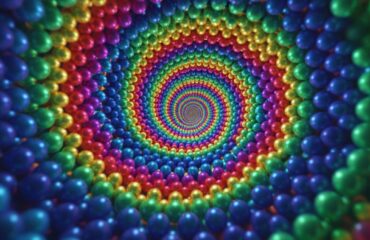
Image generated using Ideogram AI
By Mariana Meneses and James Myers
Synchrotron radiation and neutron beams allow scientists to probe the fundamental properties of materials by, essentially, illuminating matter.
Using different methods, both technologies are yielding surprising insights with a range of potential applications, including drug development, soil management, and biosecurity.
Synchrotron radiation is emitted when charged particles such as electrons are accelerated to near-light speeds. Its brilliant light energy serves as a powerful probe for examining the atomic and molecular structures of matter. This intense electromagnetic radiation allows scientists to study the composition, arrangement, and behavior of atoms and molecules in unprecedented detail, advancing many scientific disciplines by unveiling the hidden intricacies of materials.
Researchers are also discovering more about the structure of matter through the use of neutron beams that are generated through nuclear spallation processes.
Using a particle accelerator, a beam of positively-charged protons is directed at a heavy metal like lead, exciting its atomic nuclei which eject neutrons as the energy dissipates. The process is far more energy efficient than nuclear fission, and unlike fission it doesn’t provoke a chain reaction. The beams of neutrons provide a unique perspective by interacting with the atomic nuclei of materials. Neutrons, being electrically neutral, penetrate deep into matter without interference, allowing researchers to explore the internal structure and dynamics of materials with exceptional clarity.
Together, these technologies enable scientists to illuminate different types of matter in ways that were once unimaginable, offering invaluable insights into their properties, functions, and potential applications in fields ranging from materials science and physics to biology and chemistry.

Brazil’s Sirius Synchrotron. Image: CNPEM
In a previous TQR article, we introduced Sirius, a fourth-generation synchrotron operated by the Brazilian Center for Research in Energy and Materials (CNPEM), which is among the world’s most advanced synchrotrons in its ability to explore atomic structures and molecular composition.
Sirius harnesses synchrotron light, an intensely bright electromagnetic radiation emitted when charged particles, such as electrons, are accelerated to near-light speeds in a loop held together by a magnetic field that synchronizes with the increasing kinetic energy of the particles.
This cutting-edge facility, initiated in 2014, represents a quantum leap from its predecessor, UVX, offering light beams a billion times brighter and enabling profound insights into a myriad of scientific disciplines. With its diverse array of beamlines optimized for various experiments, Sirius facilitates groundbreaking research across sectors like materials science, physics, chemistry, and health.
In its YouTube channel [English subtitles available], the CNPEM explains that Sirius is,
“like an immense microscope which allows us to look inside materials at the level of their molecules and atoms to understand how they work. Sirius can be used in research of different areas that impact the development of medicine, food, fertilizers, new energy sources, among many other possibilities”.
Its 2023 milestone in the analysis of Covid-19 virus proteins underscores the pivotal role of Sirius in accelerating scientific discovery and innovation on a global scale.
Through a collaborative effort led by researchers from the University of São Paulo in São Carlos, new discoveries about the Mpro protein, essential for Sars-CoV-2 replication, have emerged. Surprisingly, the study found that Mpro can mature without a step previously thought to be necessary, challenging existing ideas. Additionally, the study revealed how different drugs interact with Mpro, offering valuable insights for developing Covid-19 treatments.
Plans are currently under development to use Sirius’ synchrotron light to explore the compacted structure of soil 30-70 centimetres below ground in Brazil’s coastal tableland areas. Created by sediments, the soil becomes extremely hard as it dries, which degrades the roots and nutrient absorption of surface vegetation and poses problems for agriculture, land management, and conservation. It is hoped that added knowledge on the basis for the soil’s cohesion will lead to innovative solutions that could benefit an area of 100,000 square kilometres in northeastern Brazil.

“Plan for the new Orion laboratory complex, integrated with Sirius.” Image: CNPEM
Recently, the CNPEM announced that Brazil is set to pioneer a groundbreaking venture in biosafety research with the construction of the world’s first maximum biosafety containment laboratory complex integrated with a synchrotron light source.
Spearheaded by CNPEM and funded by the Ministry of Science, Technology and Innovation, this ambitious project, named Orion, will connect to three of Sirius’s beamlines and provide a unique platform for advanced pathogen research. Orion’s laboratories will function at the highest level of pathogen containment, biosafety level 4, and with a budget of approximately 1 billion reais (about 200 million US dollars) they are expected to be operational by 2026.
This facility will enable research on class 3 and 4 pathogens, which include the deadly Marburg and Ebola viruses, empowering Brazil to address emerging infectious threats and contribute to global health security.

“Research Infrastructure European Spallation Source, Lund, Sweden – Aerial View.” Image: Roger Eriksson/ESS
Across the ocean, the European Spallation Source (ESS) is a multi-disciplinary research facility currently under construction in Lund, Sweden. The ESS aims to provide unique insights into the structure and properties of materials for various fields including biology, chemistry, physics, and engineering.
Using nuclear spallation, a safer process than uranium fission, the facility will generate intense pulses of neutrons for research purposes. ESS will feature the world’s most powerful linear accelerator to create high-speed collisions of protons with a tungsten target to emit neutrons. These neutrons will then be directed to experimental stations where research on a wide range of materials can be conducted.
Plans are to use the neutron beams to explore materials for clean energy and environmental technologies, to develop pharmaceuticals and advance healthcare, to probe biological structures, further nanotechnologies, and aid with food science and cultural preservation. With its groundbreaking capabilities in neutron scattering, ESS promises to advance scientific understanding and contribute to the development of new materials and processes on a global scale.

ESS Accelerator tunnel, 2021. Image: ESS
As of April 2024, the ESS is making significant strides towards its goal of being operational by 2025, with a suite of instruments set to be ready for the “Beam on Target milestone.”
This suite includes four instruments – LOKI, ODIN, DREAM, and BIFROST – along with the Test Beamline (TBL). These instruments will play pivotal roles in a diverse array of scientific research, and BIFROST, with its focus on the dynamic response of complex quantum materials, promises breakthroughs in IT and energy research. Progress on these instruments is well underway, with activities such as detector installation for BIFROST, infrastructure installations for LOKI and ODIN, and the equipping of DREAM with detector modules.
The Test Beamline will provide a crucial benchmark for analyzing neutron beams, with infrastructure installations and detector testing underway. Looking ahead, ESS aims to have all four instrument stations and the Test Beamline fully installed by the end of the year, with commissioning activities slated to begin in late 2024.
Furthermore, plans are in place for the completion of fifteen scientific instruments and a Test Beamline by the end of 2027, paving the way for a diverse range of research opportunities in fields spanning from materials science to biological systems.

Image generated using Ideogram AI.
Synchrotrons and neutron beams are the latest steps in a quest of over 2,000 years to understand the tiniest constituents of matter.
In ancient Greece, the philosopher Democritus proposed the atom as the fundamental unit of matter, physically indivisible and indestructible. Fast forward to the late 19th century, when J.J. Thomson discovered the electron and shook things up by revealing that atoms are made up of even smaller subatomic particles. This paved the way for Ernest Rutherford’s famous gold foil experiment in 1909, which demonstrated that atoms have a dense nucleus at their center, surrounded by a cloud of electrons.
Niels Bohr further refined this model in 1913, proposing that electrons orbit the nucleus in discrete energy levels, like planets around the sun. Finally, in the 20th and 21st centuries, advancements in quantum mechanics have provided even deeper insights into the behavior of atoms, revealing the wave-particle duality of light and matter and the probabilistic nature of electron distribution within atoms.
Thus, from the ancient Greeks to modern quantum theory, our understanding of the atom has evolved dramatically, redefining our view of the fundamental building blocks of the universe. As we develop ever more advanced technology to look inside matter, we illuminate previously hidden places of nature and reality itself, with important implications for the power humans have to change our environment, such as fighting diseases and increasing the human lifespan on Earth.
Craving more information? Check out these recommended TQR articles:
- A Different Way to Explore the Brightest Light of the Universe: Synchrotrons
- Evolving Time: Can We Extend Our Lifespan, and the Earth’s Life Too?
- Finding Truths: Defense and Criticism of the Scientific Method
- The Puzzle of the Neutrino: Does It Account for Dark Matter?
- Shedding a New Light on Electrons: 2023 Nobel Prize in Physics Awarded for Imaging Fundamental Particle
- Increasing Precision in Time Measurement, From the Atom to the Cosmos



